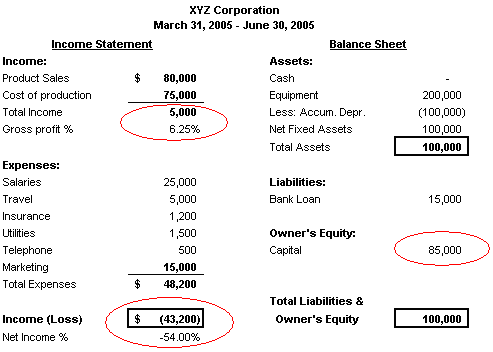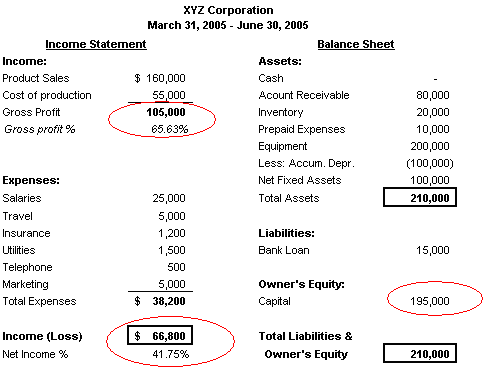CFA Level 1 - Financial Statements
A. Financial Statement Analysis
The income statement is a statement of earnings that shows managers and investors whether the company made money over the period of time being reported. This statement details the revenues of the firm as well as the expenses incurred to achieve them, and transforms this into net income. The conclusion of the statement is to show the firm’s gains or losses for the period.
The balance sheet reports the company’s financial position at a specific point in time. The balance sheet is made up of three parts: assets, liabilities and owners’ equity. Assets detail the firm’s economic resources that have been built up through the firm’s operations or acquisitions. Liabilities are the current or estimated obligations of the firm. The difference between assets and liabilities is known as net assets or net worth of the firm. The net assets of the firm are also known as owners’ equity, which is amount of assets that would remain once all creditors are paid. According to the accounting equation, owners’ equity equals assets minus liabilities
Assets – Liabilities = Owners’ Equity
The statement of cash flows reconciles the firm’s net income to its reports on the company’s cash inflows and outflows. It shows how changes in balance sheet accounts and income affect cash and cash equivalents. These cash receipts and payments are categorized as by operating cash flows, investing cash flows and financing cash flows
The statement of changes in owners’ equity reports the sources and amounts of changes in owners’ equity over the period of time being reportedLet's consider a practical example to fully understand the impact of Cash versus Accrual Accounting on XYZ Corporation's Income Statement and Balance Sheet.
Cash Basis AccountingTaken as is, the financial statements in Figure 6.1 below indicate that XYZ Corporation is not doing well, with a net loss of $43,200, and may not be a good investment opportunity.
Figure 6.1: XYZ Corporation's Financial Statements using Cash Basis Accounting
The statement of changes in owners’ equity reports the sources and amounts of changes in owners’ equity over the period of time being reportedLet's consider a practical example to fully understand the impact of Cash versus Accrual Accounting on XYZ Corporation's Income Statement and Balance Sheet.
Cash Basis AccountingTaken as is, the financial statements in Figure 6.1 below indicate that XYZ Corporation is not doing well, with a net loss of $43,200, and may not be a good investment opportunity.
Figure 6.1: XYZ Corporation's Financial Statements using Cash Basis Accounting
 |
Accrual Basis AccountingArmed with some additional information, let's see what the income statement would look like if the accrual-basis accounting method was used.
Additional Information:
A1.
A2.
A3.
Figure 6.2: XYZ Corporation's Restated Financial Statements using Accrual Basis Accounting
 |
Note: tax effect not considered
Adjustments:To obtain the figures in the restated financial statements in figure 6.2 above, the following adjusting entries were made:
A1. Product sales and Accounts receivable - Even though the client has not paid this invoice, the company still made a sale and delivered the products. As a result, sales for the accounting period should increase by $80,000. Account s receivables (reported sales made but awaiting payment) should also increase by $80,000.
Adjusting entries:
A2.
Adjusting entries:
A3.
Adjusting entries:
Results:
Under cash-basis accounting, this company was not profitable and its balance sheet would have been weak at best. Under accrual accounting, the financials tell us a very different story.
Accrual accounting requires that revenue is recorded when the firm earns it, and that expenses are taken when the firm incurs them regardless of when the cash is actually received or paid. If cash is received first then an unearned revenue or prepaid expense account is set up and decreased as the revenue and expense is recorded over time. If cash is received after goods are delivered then the revenue and expense is recorded and a receivables or payables account is set up and decreased as the cash is paid. Most accruals fall into one of four categories:
1. Accrued Revenues: A firm will usually earn revenue before it is actually paid for its goods or services. Typically the asset account for accounts receivable is increased until the customer actually pays for goods that have been invoiced. The company records the revenue when the goods are delivered and invoiced. The accounts receivable account is decreased when the customer pays the invoice in cash.
2. Unearned Revenue: Some firms collect income before goods are provided. Subscriptions are examples of goods that are prepaid, but the revenue is not recognized until the goods are delivered. In this situation the firm increases the asset account cash and a liability account for unearned income. Unearned income is decreased as revenue is earned over time.
3. Accrued Expenses: Most firms buy inventories and supplies on account and pay for them after they have been invoiced. When the goods are delivered and equal amount is recorded in the expense account and in accounts payable. When the invoice is paid, cash and the accounts payable account are decreased.
4. Prepaid Expenses: Some companies pay some expenses in advance. A prepaid expanse account is increased and the actual expense is not recorded until the actual goods or services are delivered.
2. Unearned Revenue: Some firms collect income before goods are provided. Subscriptions are examples of goods that are prepaid, but the revenue is not recognized until the goods are delivered. In this situation the firm increases the asset account cash and a liability account for unearned income. Unearned income is decreased as revenue is earned over time.
3. Accrued Expenses: Most firms buy inventories and supplies on account and pay for them after they have been invoiced. When the goods are delivered and equal amount is recorded in the expense account and in accounts payable. When the invoice is paid, cash and the accounts payable account are decreased.
4. Prepaid Expenses: Some companies pay some expenses in advance. A prepaid expanse account is increased and the actual expense is not recorded until the actual goods or services are delivered.
Debit:An accounting term that refers to an entry that increases an expense or asset account, or decreases an income, liability or net-worth account. Credit: An accounting term that refers to an entry that decreases an expense or asset account, or increases an income, liability or net-worth account. |
Going forward, all statements will use accrual-basis accounting. Please note that on the exam, candidates should assume that all financial statements use accrual-basis accounting, unless it is specified that the cash-basis accounting method is used in the question. |






0 comments:
Post a Comment